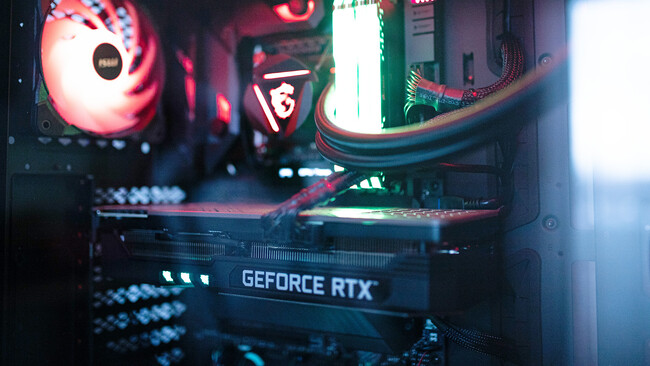In the world of technology, the graphics card is a fundamental component for both graphic design professionals and gaming enthusiasts. This device is crucial for rendering images, videos and animations with the highest quality and efficiency possible. In this blog, we will explore what a graphics card is, its importance in graphic design and its essential role in gaming. We’ll also offer advice on how to choose the best graphics card for your needs.
What is a Graphics Card?
A graphics card, also known as a GPU (Graphic Processing Unit), is a hardware component dedicated to creating and rendering images and graphics on your computer. While the CPU (Central Processing Unit) handles the general and logical operations of the system, the GPU specializes in processing complex graphical tasks with high efficiency.
How a Graphics Card Works
Graphics cards work by executing parallel calculations. This means they can handle multiple operations at the same time, which is essential for processing high-resolution graphics and videos quickly. The GPU takes instructions from the CPU and converts them into images that are displayed on the monitor. The more powerful the GPU, the faster and better quality the graphics will be rendered.
Components of a Graphics Card
- GPU: The main chip that performs graphics calculations.
- VRAM: Dedicated memory for storing textures and graphics data.
- Connection interface: Generally PCIe, which connects the card to the motherboard.
- Video outputs: Ports such as HDMI, DisplayPort and DVI to connect monitors.
Importance in Graphic Design
Performance and Efficiency
For graphic designers, a powerful graphics card is essential for handling resource-intensive design and editing applications. Programs like Adobe Photoshop, Illustrator, and After Effects use the GPU to speed up image and effects processing, allowing for faster, smoother editing.
High Quality Rendering
The ability to render complex, high-resolution graphics is crucial in graphic design. A suitable graphics card can handle real-time rendering, allowing designers to see changes and adjustments instantly, improving work accuracy and efficiency.
Multiple Monitor Management
Design professionals often use multiple monitor setups to expand their workspace. A good graphics card can support multiple displays without compromising performance, allowing for a more efficient and productive workflow.
Compatibility with Design Software
Professional graphics cards, such as the NVIDIA Quadro and AMD Radeon Pro series, are specifically designed for compatibility and optimization with design software. These cards offer specific drivers and support that ensure optimal performance and stability in creative applications.
Importance in Gaming
Immersive Gaming Experience
In gaming, the graphics card is the most critical component for an immersive and fluid gaming experience. A powerful GPU can render graphics in high definition, providing stunning and realistic visual details that enhance the gaming experience.
High Frames Per Second (FPS) Rates
High-end graphics cards can maintain high frame rates per second, which is essential for smooth, stutter-free gameplay. Modern, demanding games require GPUs that can handle complex graphics without dropping performance, ensuring a smooth, lag-free gaming experience.
Support for Advanced Technologies
The latest graphics cards support advanced technologies such as ray tracing, which simulates the real behavior of light to create more realistic visual effects. They also offer support for VR (Virtual Reality), providing a completely immersive gaming experience.
Overclocking and Customization
Many gamers seek to maximize the performance of their graphics cards by overclocking, which increases the clock speed of the GPU to improve performance. Modern graphics cards allow for advanced customization, with software that makes it easy to adjust parameters and monitor temperatures and performance.
How to Choose the Best Graphics Card for Your Needs
Needs Assessment
Before choosing a graphics card, it’s important to evaluate your specific needs. If you are a professional graphic designer, you may need a card with more VRAM and advanced rendering capabilities. If you’re a gamer, you’ll look for a card that offers high FPS rates and support for the latest gaming technologies.
Comparison of Models and Brands
Research and compare different models and brands of graphics cards. NVIDIA and AMD are the main manufacturers, offering a wide range of options from entry models to high-end GPUs. Consider factors such as VRAM, clock speeds, and additional features such as ray tracing and VR support.
Budget
Determine your budget before making a purchase. Graphics cards can vary significantly in price, and it’s important to find a balance between cost and performance. Sometimes a mid-range card can offer the best value for your money, providing solid performance without breaking the bank.
Review and Opinions
Read reviews and opinions from other users to get an idea of the performance and reliability of the graphics card you are considering. Professional reviews and benchmarks can provide valuable information on how the card performs in different scenarios.
Conclusion
The graphics card is an essential component for both graphic design and gaming. Its ability to render high-quality graphics and handle processing-intensive tasks makes it crucial for optimal performance and a superior viewing experience. When choosing a graphics card, consider your specific needs, research different models and brands, and find a balance between cost and performance.
To find the perfect graphics card for your needs, visit the Ibertrónica Graphics Cards, where you can explore a wide range of options that will help you take your graphic design or gaming to the next level.
With the right graphics card, you can ensure that your PC is ready to handle any task, providing exceptional performance and an unmatched visual experience.







